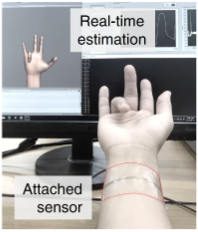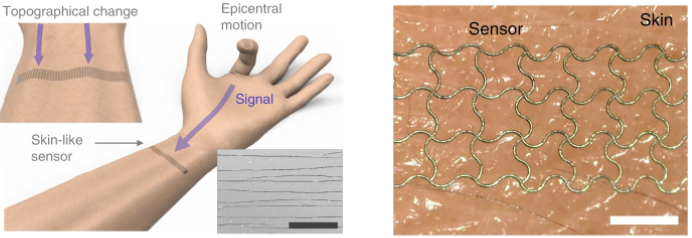Deep-Learning E-Skin Can Decode Complex Human Motion
The e-skin is able to decode complex human motion using only one sensor point.
A deep-learning powered single-strained electronic skin sensor has been developed by researchers at The Korea Advanced Institute of Science and Technology (KAIST), that can capture human motion from a distance.
The scientists behind the work say it could “provide a turning point in health-monitoring, motion tracking, and soft robotics.”
RELATED: ELECTRONIC SKIN CLOSE TO REALITY WITH SELF-HEALING SENSORS
Deep-learning e-skin
When placed on a person’s wrist, the electronic single strain skin sensor can capture human motion from a distance. It is able to decode complex five-finger motions in real-time with a virtual 3-D hand that mirrors the original motions.

Impressively, via rapid situation learning (RSL), the deep neural network is able to ensure stable operation regardless of its position on the surface of the skin.

Impressively, via rapid situation learning (RSL), the deep neural network is able to ensure stable operation regardless of its position on the surface of the skin.
A new sensing paradigm for motion tracking
Conventional wafer-based fabrication approaches have required many sensor networks to cover the entire curvilinear surfaces of the target area.
The researchers’ laser fabrication approach provides a new sensing paradigm for motion tracking, TechXplore explains.
The research team, led by Professor Sungho Jo from the School of Computing, collaborated with Professor Seunghwan Ko from Seoul National University in order to design the new measuring system, which is based on the idea that pinpointing a single area is more efficient for identifying movements than fixing several sensors on different joints and muscles.
A technological turning point
The system they built extracts signals corresponding to multiple finger motions by generating cracks in metal nanoparticle films using laser technology.
Thanks to its rapid situation learning (RSL) system, the sensor can track the motion of an entire person’s body with a small sensory network, allowing indirect remote measurement of human motions — something the researchers say is applicable for advanced VR and AR systems.
“Our system is expandable to other body parts. We already confirmed that the sensor is also capable of extracting gait motions from a pelvis,” Professor Jo told TechXplore.
“This technology is expected to provide a turning point in health-monitoring, motion tracking, and soft robotics,” he explained.
The team’s findings are published in Nature Communications.
 SHOW COMMENT ()
SHOW COMMENT ()










